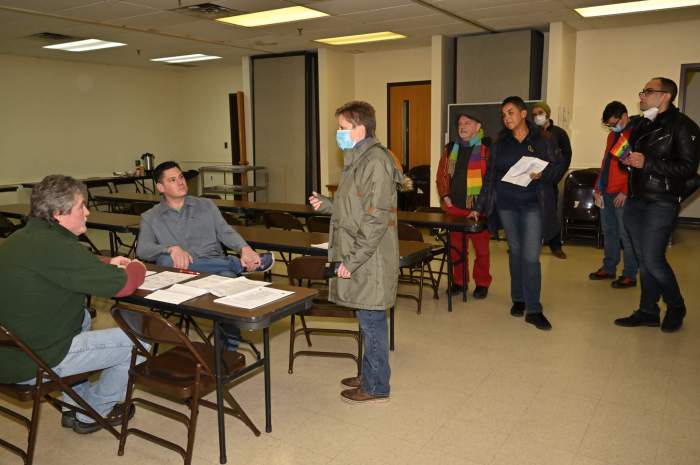BY JERRY TALLMER
Georgia on her mind
Playwright Ford portrays painterly pattern-smasher
Halfway through “Georgia & Me,” the playwright/performer who portrays both of them, or, interlockingly, each of them, cries out: “I need to see the part of me that is her, the part of her that is me,” sounding rather more like starry-eyed Frankie Addams, age 12, in Carson McCullers’ “The Member of the Wedding,” than a woman/wife/mother now somewhat past age 12.
Her name is Sarah Ford. Much of her life has been spent in the dance. Capital D — the Dance. Today, with “Georgia & Me,” Sarah Ford hazards the theater.
Georgia O’Keeffe! What a wonderful, salty, sandy, all-American name! A man’s name, a cowboy’s name, but in fact this Georgia was very much a woman, and not just that but a warrior woman, a pattern-smasher, up against the closed male world of serious painters. And not only that, but a serious artist whose work, to some eyes, including my own, dwells in part with quiet defiance on orchid-like, vagina-like floral close-ups, many years before vagina-proud Judy Chicago and Eve Ensler were among us.
Artist O’Keeffe (1887-1986) scoffed at such a reading of those canvases, if, in later age, she said anything about such goings-on at all, and Ms. Ford’s duo-logue skirts around the subject — as did O’Keeffe herself in the course of an interview with this journalist during a late 1970’s Whitney Museum retrospective of her life’s work.
What I found was a small, terse, tough, gloomy, crusty old lady still fighting her wars against the male race and not suffering fools (like me) gladly.
Somebody else who viewed that exhibition, though not at that particular moment, was a woman named — you guessed it — Sarah Ford. It hit her between the eyes, changed her life.
“I’d been a dancer all my life,” says the tall, skinny, redheaded Juilliard alumna. “I’ve danced with José Limón and Anna Sokolow. I’ve been an adjunct professor of dance at Pace University. I got married and had two children in that time.”
And spent more hours than she should have agonizing over where to go next.
“I was born and brought up in Abilene, Texas. Georgia, though born a farm girl in Wisconsin, at an early age moved down to Amarillo and then Canyon, Texas. Wow!”
And another “Wow!” when, at the Whitney, “I saw how beautiful her work was. I did all sorts of research, there at the Whitney and at the Met. Read books about her, went to Santa Fe [where O’Keeffe spent the best part and last half of her life]. I had all this information in books and on paper, and didn’t know what to do with it.”
“Meanwhile my marriage was falling apart. So I rented a storage box at $70 a month [as in the play] and just left it all there.”
Like the TV commercial says? Your whole life is in that box?
“You got it.”
She draws a breath.
“So there I was, raising my children and getting divorced, and three years ago getting remarried and moving to Carlisle, Massachusetts, in the woods — Thoreau country, transcendental country — and from time to time I’d look in that box.
“I’m a member of the Boston theater community, in which capacity about a year and a half ago I saw a one-woman piece called ‘Truth Values,’ and suddenly realized: I want to do what she does.”
And Ford started writing. When she had something to show by way of a script, she sent it to the Midtown International Theatre Festival — and here we are.
Georgia O’Keeffe was teaching school in Texas around the time a man named Alfred Stieglitz (1864-1946) was becoming world-famous, first in his own right as a photographer and then for his gallery “291” on Fifth Avenue.
O’Keeffe had a friend in New York named Anita Pulitzer. It was to Anita that she sent some drawings along with a note: “Don’t show these to anybody, but what do you think?”
Anita Pulitzer showed them to Alfred Stieglitz, who with excitement immediately said — or subsequently said he’d said — “These are the work of a woman!” And put them on the walls of his gallery.
The great worldwide flu epidemic of 1918 hit O’Keeffe, nearly killed her. Would have killed her if Alfred Stieglitz hadn’t brought her up to New York City, put her in a small walk-up apartment in the East 50s, fed her, started taking photographs of her, fell in love with her.
O’Keeffe, whose mother had never told her she was pretty, always thought of herself as a round-face, a potato face — until she looked at those photographs of herself. “He’s given me angles!” she’d exclaimed, and said “Yes” when Alfred demanded that she marry him. Divorced his existing wife in the process.
All this is in “Georgia & Me,” along with the twice-spoken line, once from Georgia’s lips, once from Sarah’s: “I was scared all the time, but I never let that stop me.”
Remembering the terse, crusty, historic old lady whose work was illuminating the Whitney Museum that day in the late 1970s, you could fool me.
































